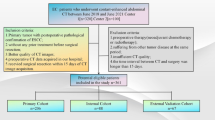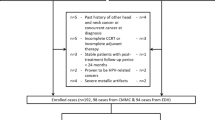Abstract
Objectives
To develop and assess a radiomics-based prediction model for distinguishing T2/T3 staging of laryngeal and hypopharyngeal squamous cell carcinoma (LHSCC)
Methods
A total of 118 patients with pathologically proven LHSCC were enrolled in this retrospective study. We performed feature processing based on 851 radiomic features derived from contrast-enhanced CT images and established multiple radiomic models by combining three feature selection methods and seven machine learning classifiers. The area under the receiver operating characteristic curve (AUC), accuracy, sensitivity, and specificity were used to assess the performance of the models. The radiomic signature obtained from the optimal model and statistically significant morphological image characteristics were incorporated into the predictive nomogram. The performance of the nomogram was assessed by calibration curve and decision curve analysis.
Results
Using analysis of variance (ANOVA) feature selection and logistic regression (LR) classifier produced the best model. The AUCs of the training, validation, and test sets were 0.919, 0.857, and 0.817, respectively. A nomogram based on the model integrating the radiomic signature and a morphological imaging characteristic (suspicious thyroid cartilage invasion) exhibited C-indexes of 0.899 (95% confidence interval (CI) 0.843–0.955), fitting well in calibration curves (p > 0.05). Decision curve analysis further confirmed the clinical usefulness of the nomogram.
Conclusions
The nomogram based on the radiomics model derived from contrast-enhanced CT images had good diagnostic performance for distinguishing T2/T3 staging of LHSCC.
Clinical relevance statement
Accurate T2/T3 staging assessment of LHSCC aids in determining whether laryngectomy or laryngeal preservation therapy should be performed. The nomogram based on the radiomics model derived from contrast-enhanced CT images has the potential to predict the T2/T3 staging of LHSCC, which can provide a non-invasive and robust approach for guiding the optimization of clinical decision-making.
Key Points
• Combining analysis of variance with logistic regression yielded the optimal radiomic model.
• A nomogram based on the CT-radiomic signature has good performance for differentiating T2 from T3 staging of laryngeal and hypopharyngeal squamous cell carcinoma.
• It provides a non-invasive and robust approach for guiding the optimization of clinical decision-making.






Similar content being viewed by others
Abbreviations
- AE:
-
Auto-encoder
- AJCC:
-
American Joint Committee on Cancer
- ANOVA:
-
Analysis of variance
- AUC:
-
Area under the receiver operating characteristic curve
- CI:
-
Confidence interval
- CT:
-
Computed tomography
- DCA:
-
Decision curve analysis
- FAE:
-
FeAture Explorer software
- GLCM:
-
Gray-level co-occurrence matrix
- GLDM:
-
Gray-level dependence matrix
- GLRLM:
-
Gray-level run length matrix
- GLSZM:
-
Gray-level size zone matrix
- GP:
-
Gaussian process
- HU:
-
Hounsfield units
- IARC:
-
International Agency for Research on Cancer
- ICCs:
-
Intra- /interclass correlation coefficients
- KW:
-
Kruskal-Wallis
- Lasso-LR:
-
Logistic regression via lasso
- LDA:
-
Linear discriminant analysis
- LHSCC:
-
Laryngeal and hypopharyngeal squamous cell carcinoma
- LR:
-
Logistic regression
- NB:
-
Naive Bayes
- NGTDM:
-
Neighboring gray tone difference matrix
- NNs:
-
Neural networks
- NPV:
-
Negative predictive value
- PACS:
-
Picture archiving and communication system
- PCC:
-
Pearson’s correlation coefficient
- PPV:
-
Positive predictive value
- RFE:
-
Recursive feature elimination
- ROI:
-
Region of interest
- SMOTE:
-
Synthetic minority over-sampling technique
- SVM:
-
Support vector machine
- TNM:
-
Tumor-node-metastasis
References
Preda L, Conte G, Bonello L et al (2017) Diagnostic accuracy of surface coil MRI in assessing cartilaginous invasion in laryngeal tumours: do we need contrast-agent administration? Eur Radiol 27(11):4690–4698
Steuer CE, El-Deiry M, Parks JR, Higgins KA, Saba NF (2017) An update on larynx cancer. CA Cancer J Clin 67(1):31–50
Sung H, Ferlay J, Siegel RL et al (2021) Global Cancer Statistics 2020: GLOBOCAN estimates of incidence and mortality worldwide for 36 cancers in 185 countries. CA Cancer J Clin 71(3):209–249
Corry J, Peters L, Kleid S, Rischin D (2013) Larynx preservation for patients with locally advanced laryngeal cancer. J Clin Oncol 31(7):840–844
Amin MB, Greene FL, Edge SB et al (2017) The Eighth Edition AJCC Cancer Staging Manual: continuing to build a bridge from a population-based to a more “personalized” approach to cancer staging. CA Cancer J Clin 67(2):93–99
Eskander A, Blakaj DM, Dziegielewski PT (2018) Decision making in advanced larynx cancer: an evidenced based review. Oral Oncol 86:195–199
Calkovsky V, Wallenfels P, Calkovska A, Hajtman A (2016) Laryngeal cancer: 12-year experience of a single center. Adv Exp Med Biol 911:9–16
Yang Y, Li L, Zheng Y et al (2020) A prospective, single-arm, phase II clinical trial of intraoperative radiotherapy using a low-energy X-ray source for local advanced Laryngocarcinoma (ILAL): a study protocol. BMC Cancer 20(1):734
Hogg GE, Thompson CSG, Asimakopoulos P, Hay A, Nixon IJ (2021) Is elective contralateral neck dissection necessary in 53 salvage total laryngectomy patients? Clin Otolaryngol 46(4):841–845
Tawfik GM, Makram OM, Zayan AH et al (2021) Voice rehabilitation by voice prostheses after total laryngectomy: a systematic review and network meta-analysis for 11,918 patients. J Speech Lang Hear Res 64(7):2668–2681
Hermans R (2006) Staging of laryngeal and hypopharyngeal cancer: value of imaging studies. Eur Radiol 16(11):2386–2400
Sulfaro S, Barzan L, Querin F et al (1989) T staging of the laryngohypopharyngeal carcinoma. A 7-year multidisciplinary experience. Arch Otolaryngol Head Neck Surg 115(5):613–620
Becker M, Burkhardt K, Dulguerov P, Allal A (2008) Imaging of the larynx and hypopharynx. Eur J Radiol 66(3):460–479
Mendenhall WM, Dagan R, Bryant CM, Amdur RJ, Mancuso AA (2016) Definitive radiotherapy for squamous cell carcinoma of the glottic larynx. Cancer Control 23(3):208–212
Mendenhall WM, Werning JW, Hinerman RW, Amdur RJ, Villaret DB (2004) Management of T1–T2 glottic carcinomas. Cancer 100(9):1786–1792
Murakami R, Nishimura R, Baba Y et al (2005) Prognostic factors of glottic carcinomas treated with radiation therapy: value of the adjacent sign on radiological examinations in the sixth edition of the UICC TNM staging system. Int J Radiat Oncol Biol Phys 61(2):471–475
Harris AS, Passant CD, Ingrams DR (2018) How reliably can computed tomography predict thyroid invasion prior to laryngectomy? Laryngoscope 128(5):1099–1102
Kinshuck AJ, Goodyear PW, Lancaster J et al (2012) Accuracy of magnetic resonance imaging in diagnosing thyroid cartilage and thyroid gland invasion by squamous cell carcinoma in laryngectomy patients. J Laryngol Otol 126(3):302–306
Liang C, Huang Y, He L et al (2016) The development and validation of a CT-based radiomics signature for the preoperative discrimination of stage I-II and stage III-IV colorectal cancer. Oncotarget 7(21):31401–31412
Sun Y, Hu P, Wang J et al (2018) Radiomic features of pretreatment MRI could identify T stage in patients with rectal cancer: preliminary findings. J Magn Reson Imaging. https://doi.org/10.1002/jmri.25969
Wang Y, Liu W, Yu Y et al (2020) Prediction of the depth of tumor invasion in gastric cancer: potential role of CT radiomics. Acad Radiol 27(8):1077–1084
Guo R, Guo J, Zhang L et al (2020) CT-based radiomics features in the prediction of thyroid cartilage invasion from laryngeal and hypopharyngeal squamous cell carcinoma. Cancer Imaging 20(1):81
Wang F, Zhang B, Wu X et al (2019) Radiomic nomogram improves preoperative T category accuracy in locally advanced laryngeal carcinoma. Front Oncol 9:1064
Kuno H, Onaya H, Fujii S, Ojiri H, Otani K, Satake M (2014) Primary staging of laryngeal and hypopharyngeal cancer: CT, MR imaging and dual-energy CT. Eur J Radiol 83(1):e23-35
Mo X, Wu X, Dong D et al (2020) Prognostic value of the radiomics-based model in progression-free survival of hypopharyngeal cancer treated with chemoradiation. Eur Radiol 30(2):833–843
Liu X, Long M, Sun C et al (2022) CT-based radiomics signature analysis for evaluation of response to induction chemotherapy and progression-free survival in locally advanced hypopharyngeal carcinoma. Eur Radiol 32(11):7755–7766
Yao Y, Jia C, Zhang H et al (2023) Applying a nomogram based on preoperative CT to predict early recurrence of laryngeal squamous cell carcinoma after surgery. J Xray Sci Technol 31(3):435–452
Theodorsson-Norheim E (1986) Kruskal-Wallis test: BASIC computer program to perform nonparametric one-way analysis of variance and multiple comparisons on ranks of several independent samples. Comput Methods Programs Biomed 23(1):57–62
Dziegielewski PT, O'Connell DA, Klein M et al (2012) Primary total laryngectomy versus organ preservation for T3/T4a laryngeal cancer: a population-based analysis of survival. J Otolaryngol Head Neck Surg 41(Suppl 1):S56-64
Li B, Bobinski M, Gandour-Edwards R, Farwell DG, Chen AM (2011) Overstaging of cartilage invasion by multidetector CT scan for laryngeal cancer and its potential effect on the use of organ preservation with chemoradiation. Br J Radiol 84(997):64–69
Laccourreye O, Malinvaud D, Menard M, Consoli S, Giraud P, Bonfils P (2014) Total laryngectomy or laryngeal preservation for advanced laryngeal cancer. Impact of the functional risk upon the patient's preferences. Eur Ann Otorhinolaryngol Head Neck Dis 131(2):93–97
Blitz AM, Aygun N (2008) Radiologic evaluation of larynx cancer. Otolaryngol Clin North Am 41(4):697–713, vi
Ryu IS, Lee JH, Roh JL et al (2015) Clinical implication of computed tomography findings in patients with locally advanced squamous cell carcinoma of the larynx and hypopharynx. Eur Arch Otorhinolaryngol 272(10):2939–2945
Kumar V, Gu Y, Basu S et al (2012) Radiomics: the process and the challenges. Magn Reson Imaging 30(9):1234–1248
Jing R, Wang JT, Li JB et al (2021) A wavelet features derived radiomics nomogram for prediction of malignant and benign early-stage lung nodules. Sci Rep 11(1):22330
Zhou JL, Lu JH, Gao C et al (2020) Predicting the response to neoadjuvant chemotherapy for breast cancer: wavelet transforming radiomics in MRI. BMC Cancer 20(1):100
Chaddad A, Daniel P, Niazi T (2018) Radiomics evaluation of histological heterogeneity using multiscale textures derived from 3D wavelet transformation of multispectral images. Front Oncol 8:96
Demircioglu A (2022) Benchmarking feature selection methods in radiomics. Invest Radiol 57(7):433–443
Shu J, Tang Y, Cui J et al (2018) Clear cell renal cell carcinoma: CT-based radiomics features for the prediction of Fuhrman grade. Eur J Radiol 109:8–12
Liang M, Cai ZT, Zhang HM et al (2019) Machine learning-based analysis of rectal cancer MRI radiomics for prediction of metachronous liver metastasis. Acad Radiol 26(11):1495–1504
Vickers AJ, Holland F (2021) Decision curve analysis to evaluate the clinical benefit of prediction models. Spine J 21(10):1643–1648
Kniep HC, Madesta F, Schneider T et al (2019) Radiomics of Brain MRI: utility in prediction of metastatic tumor type. Radiology 290(2):479–487
Funding
This study was supported by the Sichuan Science and Technology Program of China (Grant No. 2022YFS0616), the Sichuan University & Luzhou Collaborative Foundation (Grant No. 2017CDLZ-G27, 2018CDLZ-11), the Luzhou Science & Technology Department (Grant No. 2022-SYF-60), and the Project for Doctors of Affiliated Hospital of Southwest Medical University (Grant No. 2018-17129).
Author information
Authors and Affiliations
Corresponding author
Ethics declarations
Guarantor
The scientific guarantor of this publication is Guangxiang Chen.
Conflict of interest
The authors of this manuscript declare no relationships with any companies, whose products or services may be related to the subject matter of the article.
Statistics and biometry
No complex statistical methods were necessary for this paper.
Informed consent
Written informed consent was waived by the Institutional Review Board.
Ethical approval
Institutional Review Board approval was obtained.
Study subjects or cohorts overlap
No study subjects or cohorts have been previously reported.
Methodology
• retrospective
• diagnostic study
• performed at one institution
Additional information
Publisher's Note
Springer Nature remains neutral with regard to jurisdictional claims in published maps and institutional affiliations.
Supplementary Information
Below is the link to the electronic supplementary material.
Rights and permissions
Springer Nature or its licensor (e.g. a society or other partner) holds exclusive rights to this article under a publishing agreement with the author(s) or other rightsholder(s); author self-archiving of the accepted manuscript version of this article is solely governed by the terms of such publishing agreement and applicable law.
About this article
Cite this article
Liu, Q., Liu, S., Mao, Y. et al. Machine learning model to preoperatively predict T2/T3 staging of laryngeal and hypopharyngeal cancer based on the CT radiomic signature. Eur Radiol (2024). https://doi.org/10.1007/s00330-023-10557-8
Received:
Revised:
Accepted:
Published:
DOI: https://doi.org/10.1007/s00330-023-10557-8




